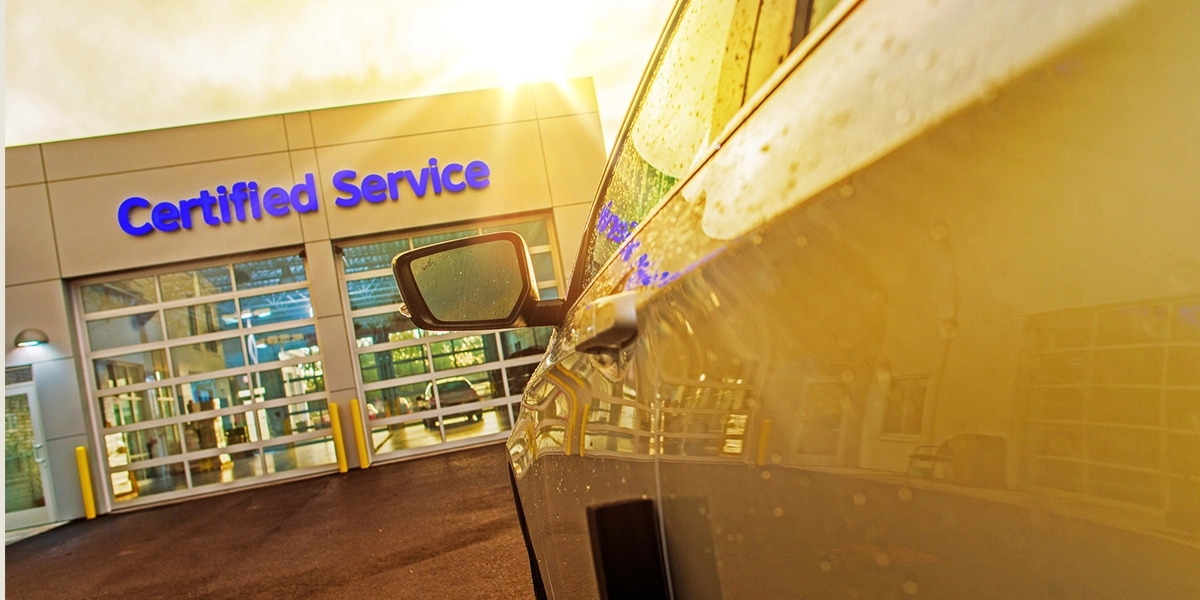Tweddle Group’s Ralph Pompea has had a front row seat for some seismic shifts in automotive service. From working as a drivability technician to supporting essential tool programs, he’s watched vehicle systems transform from purely mechanical to highly computerized, and he’s seen the impacts these changes have had in both dealership and independent service bays.
And he takes the work home with him, where he’s currently converting internal combustion engine (ICE) vehicles over to purely electric using some of the most cutting-edge EV components on the market.
As Senior Director of Global Business Development, Ralph was involved in the early stages of a new program to integrate the Troubleshooter diagnostics system into the connected vehicle ecosystem.
We talked to him about this groundbreaking project, and how it’s poised to revolutionize the diagnostic process in the service bay.
Ralph, we’ve talked at length about guided diagnostics and Tweddle Group’s own Troubleshooter system. As technicians get more comfortable with these kinds of platforms, it seems the stage is set for a new phase in automotive service. From your perspective, what’s emerging in automotive service and how does Troubleshooter address the emerging trends?
Well, one of the biggest changes that I’ve seen is definitely remote service. That is, technicians who go to the customer’s location.
It’s a development that first got pushed out to multiple industries. It’s very true in heavy duty truck, in agriculture, and most recently it came to the passenger car automotive market, where it gathered steam during the pandemic. Obviously, because people were stuck at home and they still needed to get their cars fixed.
So, remote service was a practical development in the lockdown environment, and it’s great. But it’s also tricky. You know, before, these technicians had their shop foreman observing them and managing their activity. The shop foreman has all this experience and helps the technicians diagnose and react accordingly. And in the remote context, that shop foreman is gone, along with this guidance and oversight.
So how do you have that shop foreman come with you? How do you provide the benefit of his expertise when he’s not there?
Guided diagnostics is one of those new tools that fills the gap, and it can help take the place of that experienced individual who was able to look over your shoulder and give you direction. Now, that guidance can be there 24/7. And it has its place in the shop, too, because it means you don’t have to wait for him to finish talking to Bill before he can help you. Guided diagnostics, and especially Troubleshooter, makes that guidance available to everyone at all times.
So once you’ve brought that kind of focused product knowledge into the service bay, and then to remote service, where does Troubleshooter go from there?
I would say the next port of call is the connected vehicle. You have Troubleshooter for the connected vehicle, embedded and performing its own, automated guided diagnostics in real time.
Okay, and how does that play out for the vehicle and, more importantly, for the driver and the technician?
You have Troubleshooter in the connected vehicle observing systems operation, monitoring component performance, and monitoring the interrelationships from a big picture view, as well. Troubleshooter’s guided diagnostics system is able to identify problems and even potential problems.
It’s then able to notify the customer as needed.
It can say to the driver, “Hey, we’ve got an issue—or we’re going to have an issue—and you need to hit your service location so they can correct it.”
So, that’s the immediate driver impact—you’re aware of an issue immediately, or you’re alerted to a need for preventive maintenance well before the issue strands you out on the side of the road somewhere.
Next step, the driver schedules their service appointment, goes in, has their issue taken care of before it becomes an issue, and they’re on their way. Trouble averted. From the customer perspective, that’s a really seamless, friction-free style of ownership.
"The driver becomes aware of a potential issue immediately, before it strands them on the side of the road."
Troubleshooter for the Connected Vehicle… and Safer Driving
It beats being stuck on the side of the freeway.
It absolutely does. That’s the driver perspective. You’re able to resolve an issue with very little hassle and at minimal cost.
But what I see as an even more significant benefit here is that Troubleshooter for the connected vehicle can then send a pre-populated diagnostic report to the service outlet, ahead of the driver bringing the vehicle in. So, when the car rolls into that service bay, they’ve already got this report telling them, “Hey, this is what could be wrong here. Here’s all the data the system’s observing. You’re going to want to check A, B, C, and D, and in that order.”
So, the repair is already started before the vehicle shows up.
Right. And that’s where this becomes really important.

What was the impetus for this sort of development? On one hand it’s groundbreaking but given the technology in place, it almost feels like a no-brainer.
Well, it started with, you know, OnStar and other vehicle offerings similar to that, where the OEM would get detailed feedback from the vehicle if the owner opted in to share the data.
This is where the private information becomes very interesting, and most OEMs would provide a service in exchange for access to that data.
And what level of data was changing hands in these early exchanges?
Oh, things like, how fast were you driving? Accelerometers in the vehicle might show how quickly you’re braking.
Vehicles store a tremendous amount of information about their last drive cycle. It doesn’t store everything forever but, for example, I get an e-mail from my BMW every month that shows the trips I’ve taken, the length of each trip, the fuel economy, right? And it will kind of rate the trips.
Because the keys are coded to individual drivers, I can break it up and say, here are my wife’s trips, here are my trips, things like that.
That’s a lot of information. And what’s the logical extension of that?
New types of data, and the ways you can apply that data.
Right. Types of data.
In the repair world, it’s sharing some of that info so an OEM can anticipate a product failure. Let’s say they see data from your vehicle that fuel injector number 3, or battery cell number 3, depending on your vehicle. Let’s say those are no longer behaving as expected. Based on their behavior, the system can predict when the component is going to fail.
So, you get an e-mail from your car saying, “You should go in and have this checked before it leaves you stranded on the side of the road.”
[Laughs] In those exact words.
Maybe it doesn’t word it exactly like that, but it’s there to say something needs to be checked.
And the big picture here is that it’s much easier to fix something before it triggers a larger failure. I mean, to say nothing of having to order a tow-truck or roadside service.
“This damn car left me stranded on the side of the road.”
Right? Not the best customer experience.
Instead, it sent me a note and I had it fixed.
And on the OEM side…
On the OEM side, they get a message saying, “Watch for this VIN number, and it has this problem.”
Customer pulls in. The service outlet can say, “Hi, we’ve been expecting you. Appreciate you made your appointment through the app. We have a diagnostic report already, so we have a good idea what’s wrong with it. We’ve already ordered the parts. Let’s get you in immediately.”
A HEAD START FOR TECHNICIANS
Just so I understand, does this eliminate the diagnostic technician from the process?
It does not.
Okay. How so?
Well, there’s a fine line here because you don’t want the service advisor, who’s not a technician, diagnosing the vehicle.
You still want an experienced technician to validate the report and ensure the complaint, the cause and the correction all line up.
You know, repairing cars in the service drive of a dealer wasn’t a good thing in the ‘80s and it’s still not a good thing today. You’ll still want that report checked and confirmed.
The pre-populated diagnostic report says, “Based on data from the vehicle, this is what we see. This is what we anticipate.”
The technician performs the verification and confirms that’s the case.
They’re not just going to throw the part in because, you know, you don’t want that. A vehicle in California might have a different failure than a vehicle in Maryland. They’re different environments.

troubleshooter for the connected vehicle CREATES PRE-POPULATED DIAGNOSTIC REPORTS
Got it. But having that data when the car rolls in…
It’s going to be a big help for validating the issue correctly. It will streamline the write-up process. It will give the technician the data they need.
Do you see this streamlining communication within the service environment?
For sure. The biggest complaint of a technician to the service advisor is often they’re not sure what the customer’s exact complaint even is. How does it happen? When does it happen?
To know if you’ve fixed it, you need to know which conditions the vehicle experiences, and under which parameters or circumstances does it even occur? That way, if I’m the technician, I can repeat it and I can see what’s happening. Then I can fix it and I can test it and I can verify it’s no longer happening.

ELIMINATING NO-FAULT-FOUND
So, this certainly impacts the need for endless test drives. I know it’s been frustrating for me to detect an issue and then service isn’t able to replicate it.
Right. They need to hear that squeak or hear that rattle.
One big part of the service advisor’s job is to filter out the normal activity. You don’t want to write up a repair order to fix a normal condition.
With Troubleshooter in a connected vehicle, the system filters out a ton of non-issues, and really says, “Your problem is very likely in this area, so take a look here first.”
And it can give enough context and data to the technician so that when they do get a vehicle into the stall, they know exactly what they’re trying to repair. That’s going to eliminate a lot of your no-trouble-found cases.
Right.
It will alleviate the impact of, maybe, ineffective communication between the customer, the service advisor and the technician. In many cases you’ll have a no-trouble-found just because there’s been a miscommunication somewhere in that path, which is unpleasant for the technician, unpleasant for the customer and a drag for the service advisor.
"Troubleshooter then sends a pre-populated diagnostic report to the service outlet, so they know what they're dealing with before the customer even arrives."
This is a two-part question.
One, is it safe to assume, then, if Troubleshooter is on the vehicle itself, it will also be in the dealership service bay toolkit?
And, two: If so, does that create a beneficial continuity between the system’s on-the-road preventive analysis and the activity that occurs once the vehicle hits the service bay?
Yeah, it absolutely opens the door for a high level of continuity. The diagnosis that begins out on the road is continued and completed in the bay if that technician is also using Troubleshooter.
I mean, guided diagnostics takes the VIN specific information available, the real-world, real-time statistics, and it can compare that data to all the other diagnostics and repairs it’s been involved in within that ecosystem.
If other vehicles have had a similar failure, it crunches that data and gives the technician an even better idea what they need to do.

So, let’s say you have a technician who’s never seen this vehicle before, or this particular issue before. The system is basically stepping in, just like the shop foreman there to bring everyone up to speed. The system can say, “This is a common complaint. Here’s the most common failure. Look here first.”
That’s a big help to a technician and they’re not getting that just by looking at a diagnostic manual. The manual is static, it’s frozen in time, and it doesn’t provide any of this additional context.
So, the benefit of connected guided diagnostics is twofold. One, it can reorder the steps so that you know where to look first. Two, it also has all this data from the vehicle.
Think about it this way. If the system can answer your first five questions, if it can resolve the first five steps for you before you even pop the hood, then you start at step six. You don’t have to check these things because the vehicle’s already told the diagnostic system the answer to those questions.
This was definitely not possible back in the ‘80s, ‘90s and 2000s. And it’s still not possible today if you’re just looking at static reference material.
All this advantage is a direct function of the connected vehicle and the sharing of data with the diagnostic system.
In our next installment, Ralph examines the potential for a Troubleshooter customer subscription option, and the significant benefits Troubleshooter will bring to OEM warranty programs.
For more information, contact Ralph Pompea.
Tweddle Group’s Nick Horan will be at MOVE America next week, discussing Troubleshooter for the Connected Vehicle September 24-25 at Huntington Place in Detroit, Michigan. Book time with Nick at MOVE America.



